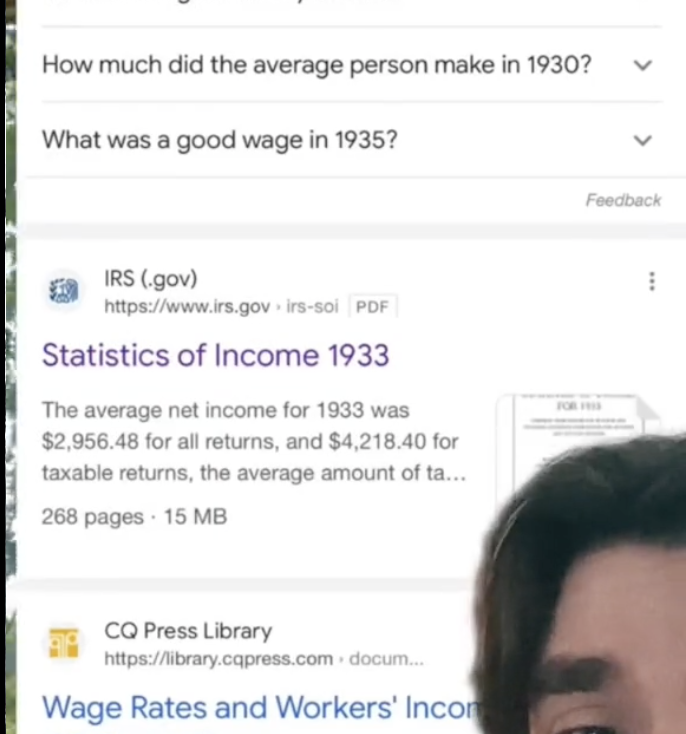In the ever-evolving world of social media trends, TikTok has seen its fair share of fascinating and sometimes perplexing content. Lately, a concerning trend has emerged where some TikTokers are romanticizing and downplaying the Great Depression, a pivotal period of economic struggle in American history. Influencers on the platform are making bold claims about the financial conditions during that era and drawing questionable comparisons to the present day.
@praxben #stitch with @The Sane Asylum #greatdepression #pooerer are we poorer than the great depression? Average income great depression. Poorer than great depression? #income #poverty #politics #economics #praxben #blockben #libertarian #conservative #liberal ♬ original sound – PraxBen IQ: 999
Numerous creators have jumped on the bandwagon, asserting that Americans during the Great Depression earned more than today’s average salary. One individua (above)l boldly stated, “In order to be making an average [salary] that is on par with what the average American was making in the lowest depths of the Great Depression, in the year 2022 you would need to be making $95,000.” Another influencer took it even further, claiming, “we are currently in the greatest depression in American history” and insisted that employed Americans in 1933 made an average of $4,200 annually, which would also be around $95,000 in today’s dollars.
These claims, however, require careful examination and fact-checking. While they may seem captivating, they are, in fact, quite misleading. The figures cited in the TikToks are based on historical data from the Internal Revenue Service (IRS). However, they conveniently omit a crucial detail—the IRS report from 1933 does mention an average salary of “$4,218.40 for taxable returns,” but this only includes a subset of 1.7 million individuals, hardly representative of the entire population.
The actual average salary during the Great Depression was approximately $1,045, which, when adjusted for inflation in 2023, would amount to about $24,526.07. This starkly contradicts the inflated numbers presented in the TikToks, which mislead viewers into believing that people during the Great Depression had higher earnings than the average salary today.
Not stopping at salary comparisons, another TikToker brought up the issue of the minimum wage, claiming that if it had remained tied to inflation, it would be $52 per hour today. However, this assertion is also inaccurate. The minimum wage was never designed to be adjusted for inflation, and the federal minimum wage of $0.25 in 1938 would only equate to $5.43 in today’s dollars.
Christopher Clarke, an assistant professor of economics at Washington State University, has been observing this TikTok trend and shares his perspective on the matter. He says, “By a long shot, most folks are genuine when making these claims, viewing the videos, or sharing it with friends. They feel that the economy is unfair, and have found a narrative that validates those sentiments.” Clarke points out that while the sentiment behind the claims may stem from genuine concerns about their economic conditions, it is essential to ensure the accuracy of the information being disseminated.
Amidst the misleading TikTok trend, it is crucial to revisit the somber realities of the Great Depression. This period, which commenced with the 1929 stock market crash, plunged the nation into an economic abyss. Unemployment soared to unprecedented levels, peaking at around 25% in 1933. Poverty became widespread, and countless families struggled to put food on the table and keep a roof over their heads. The economist Murray Rothbard noted: “…average weekly earnings fell by over 40 per cent during the depression, and real weekly earnings fell by over 30 per cent.”
Homelessness became a pressing issue, with many people forced to live in makeshift shantytowns known as “Hoovervilles.” Soup kitchens and breadlines became common sights, illustrating the desperation for even the most basic necessities. Families were torn apart, and children were compelled to work to contribute to their households’ income. The emotional and psychological toll on the nation’s citizens was immense. One study noted that the suicide rate increased from 18.0 per 100,000 in 1928 to 22.1 per 100,000 in 1932. For comparison, it was 14.1 in 2021.
Since the Great Depression we’ve come a long way. Today, we enjoy a level of comfort and convenience that was unimaginable in the 1930s. As Professor Clarke astutely pointed out: “We’ve expanded air conditioning, refrigeration, central heating, indoor plumbing, motor vehicle ownership, interstate highways, penicillin, improved cancer and diabetic treatments. I mean, reheat your two-day-old leftovers from your fridge in a microwave in sixty seconds and bask knowing such conveniences and luxuries did not exist fifty years ago.”
This doesn’t mean that everyone in America today is living a perfectly comfortable life. There are still countless improvements that can be made. Many Americans are still in poverty, and many are still homeless. But we cannot fix any prevailing economic problems if we are operating on false data and assumptions. That is what makes this trend of romanticizing and downplaying the Great Depression so concerning.
It is essential for social media users to be discerning and critical of the content they encounter, especially when it involves historical events. By recognizing the realities of the Great Depression, we can pay homage to the resilience and strength of our ancestors and strive to learn from history to build a more informed and compassionate future.

Benjamin Williams
Benjamin Williams is a fellow with FEE’s Henry Hazlitt Project for Educational Journalism. He has produced videos and written content for many libertarian organizations such as the Mises Institute and Students For Liberty. Under the alias PraxBen on TikTok, he has amassed over 200,000 followers and over 80 million views promoting sound economics and libertarianism to younger audiences.
Follow him on his TikTok, FEE’s TikTok, Instagram, Twitter, Substack, Mises, and see his appearance on the Tom Woods Show.
This article was originally published on FEE.org. Read the original article.
